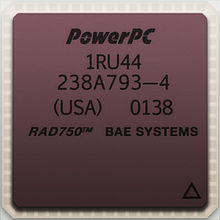RAD750
 The RAD750 | |
| General information | |
|---|---|
| Launched | 2001 |
| Discontinued | Present |
| Designed by | IBM |
| Common manufacturer | |
| Performance | |
| Max. CPU clock rate | 110 MHz to 200 MHz |
| Cache | |
| L1 cache | 32 KB instruction + 32 KB data |
| Architecture and classification | |
| Application | Radiation hardened |
| Technology node | 250 nm to 150 nm |
| Microarchitecture | PowerPC 750 |
| Instruction set | PowerPC v.1.1 |
| Physical specifications | |
| Cores |
|
| History | |
| Predecessor | RAD6000 |
| Successor | RAD5500 |
| POWER, PowerPC, and Power ISA architectures |
|---|
| NXP (formerly Freescale and Motorola) |
| IBM |
|
| IBM/Nintendo |
| Other |
| Related links |
| Cancelled in gray, historic in italic |
The RAD750 is a radiation-hardened single board computer manufactured by BAE Systems Electronics, Intelligence & Support.[1] The successor of the RAD6000, the RAD750 is for use in high radiation environments experienced on board satellites and spacecraft.[2] The RAD750 was released in 2001, with the first units launched into space in 2005.[1][3]
The CPU has 10.4 million transistors, nearly an order of magnitude more than the RAD6000 (which had 1.1 million).[3] It is manufactured using either 250 or 150 nm photolithography and has a die area of 130 mm2.[1] It has a core clock of 110 to 200 MHz and can process at 266 MIPS or more.[1] The CPU can include an extended L2 cache to improve performance.[3] The CPU itself can withstand 200,000 to 1,000,000 rads (2,000 to 10,000 gray), temperature ranges between –55 °C and 125 °C and requires 5 watts of power.[1][3] The standard RAD750 single-board system (CPU and motherboard) can withstand 100,000 rads (1,000 gray), temperature ranges between –55 °C and 70 °C and requires 10 watts of power.[3]
The RAD750 system has a price that is comparable to the RAD6000 which is US$200,000 per board (per 2002 reference).[4] However customer program requirements and quantities will greatly affect the final unit costs.
The RAD750 is based on the PowerPC 750.[1] Its packaging and logic functions are completely compatible with the PowerPC 7xx family.[3]
The term RAD750 is a registered trademark of BAE Systems Information and Electronic Systems Integration Inc.[5]
Deployment
In 2010 it was reported that there were over 150 RAD750s used in a variety of spacecraft.[6] Notable examples,[2] in order of launch date, include:
- Deep Impact comet chasing spacecraft, launched in January 2005 - first to use the RAD750 computer.[2]
- XSS 11, small experimental satellite, launched April 11, 2005[2]
- Mars Reconnaissance Orbiter, launched August 12, 2005[2]
- SECCHI (Sun Earth Connection Coronal and Heliospheric Investigation) instrument package[7] on each of the STEREO spacecraft, launched October 25, 2006
- WorldView-1 satellite, launched Sept 18, 2007 - has two RAD750s.[6]
- Fermi Gamma-ray Space Telescope, formerly GLAST, launched June 11, 2008
- Kepler space telescope, launched in March 2009[2]
- Lunar Reconnaissance Orbiter, launched on 18 June 2009
- Wide-field Infrared Survey Explorer (WISE) launched 14 December 2009[8]
- Solar Dynamics Observatory, launched Feb 11, 2010
- Juno spacecraft, launched August 5, 2011[9]
- Curiosity rover, launched November 26, 2011[10]
- Van Allen Probes, launched on August 30, 2012[11]
References
- ^ a b c d e f "RAD750 radiation-hardened PowerPC microprocessor" (PDF). BAE Systems. 2008-07-01. Retrieved 2009-04-27.
- ^ a b c d e f "RAD750". Ball Aerospace & Technologies. Retrieved 2009-03-08.
- ^ a b c d e f L. Burchin (2002-12-04), "Rad750 experience: The challenge of SEE hardening a high performance commercial processor MRQW 2002" (PDF), Microelectronics Reliability and Qualification Workshop, Manhattan Beach, CA: BAE Systems, retrieved 2009-04-30
- ^ "BAE Systems moves into third generation rad-hard processors". Military & Aerospace Electronics. 2002-05-01. Retrieved 2009-04-30.
- ^ "RAD750". Logos Database. Retrieved February 18, 2013.
USPTO serial number 75894617
- ^ a b "BAE RAD750 Radiation-Hardened SBCs Control WorldView-1 Satellite". EDA Geek. 2007-10-17. Retrieved 2009-04-28.
- ^ "The STEREO Mission". Springer. Retrieved January 20, 2014.
ISBN 978-0-387-09649-0
- ^ BAE Systems Space Computer Gives Wisdom To The WISE, spacedaily.com, 2009-12-22
- ^ "Juno Launch Press Kit" (PDF). NASA. August 2011. Retrieved February 18, 2013.
- ^ NASA Launches Most Capable and Robust Rover to Mars
- ^ Van Allen Probes Launch
External links
- RAD750 products from BAE Systems
- RAD750 Data Sheet (PDF), from BAE Systems
- BAE Systems RAD750 processor JTAG Emulator from corelis.com
- The CPUs of Spacecraft Computers in Space

